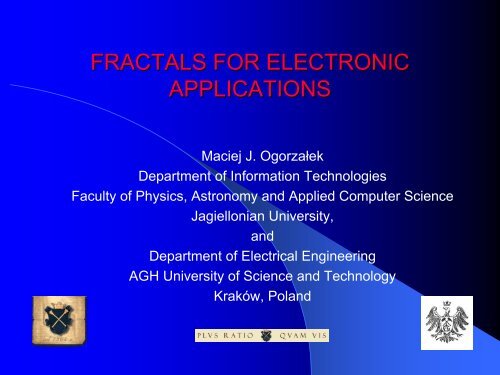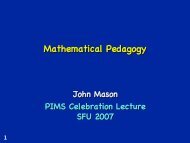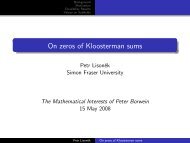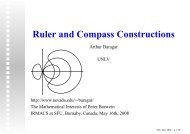FRACTALS FOR ELECTRONIC APPLICATIONS
fractals for electronic applications - International Workshop on ...
fractals for electronic applications - International Workshop on ...
Create successful ePaper yourself
Turn your PDF publications into a flip-book with our unique Google optimized e-Paper software.
<strong>FRACTALS</strong> <strong>FOR</strong> <strong>ELECTRONIC</strong><br />
<strong>APPLICATIONS</strong><br />
Maciej J. Ogorzałek<br />
Department of Information Technologies<br />
Faculty of Physics, Astronomy and Applied Computer Science<br />
Jagiellonian University,<br />
and<br />
Department of Electrical Engineering<br />
AGH University of Science and Technology<br />
Kraków, Poland
<strong>FRACTALS</strong><br />
The discovery of fractals is usually bestowed upon<br />
IBM Researcher Benoit Mandelbrot in 1976. It<br />
involved calculations that could only be achieved<br />
by an intensive iteration process performed by<br />
computers…<br />
August 18th, 2006<br />
Fractals for electronic applications<br />
Maciej J. Ogorzałek
Fractal – “broken, fragmented, irregular”<br />
“I coined fractal from the Latin adjective fractus. The corresponding<br />
Latin verb frangere means "to break" to create irregular fragments. It is<br />
therefore sensible - and how appropriate for our need ! - that, in<br />
addition to "fragmented" (as in fraction or refraction), fractus should<br />
also mean "irregular", both meanings being preserved in fragment. ”<br />
Benoit Mandelbrot : The fractal Geometry<br />
of Nature, 1982<br />
•Euclid geometry: cold and dry<br />
•Nature: complex, irregular, fragmented<br />
“Clouds are not spheres, mountains are not cones,<br />
coastlines are not circles, and bark is not smooth, nor does<br />
lightning travel in a straight line.” We are confronted with<br />
„rough” and „smooth” !!<br />
August 18th, 2006<br />
Fractals for electronic applications<br />
Maciej J. Ogorzałek
Real world fractals<br />
A cloud, a mountain, a flower, a tree<br />
or a coastline…<br />
The coastline of Britain<br />
August 18th, 2006<br />
Fractals for electronic applications<br />
Maciej J. Ogorzałek
August 18th, 2006<br />
Fractals for electronic applications<br />
Maciej J. Ogorzałek
Euclid dimension<br />
• In Euclid geometry, dimensions of objects are<br />
defined by integer numbers.<br />
• 0 - A point<br />
• 1 - A curve or line<br />
• 2 - Triangles, circles or surfaces<br />
• 3 - Spheres, cubes and other solids<br />
August 18th, 2006<br />
Fractals for electronic applications<br />
Maciej J. Ogorzałek
• For a square we have N^2 self-similar pieces for the<br />
magnification factor of N<br />
dimension=log(number of self-similar pieces)<br />
/log(magnification factor)<br />
=log(N^2)/logN=2<br />
For a cube we have N^3 self-similar pieces<br />
dimension=log(number of self-similar pieces)<br />
/log(magnification factor)<br />
=log(N^3)/logN=3<br />
Sierpinski triangle consists of three self-similar pieces<br />
with magnification factor 2 each<br />
dimension=log3/log2=1.58<br />
August 18th, 2006<br />
Fractals for electronic applications<br />
Maciej J. Ogorzałek
Example: : Cantor Set<br />
• The oldest, simplest, most famous fractal<br />
1 We begin with the closed interval [0,1].<br />
2 Now we remove the open interval (1/3,2/3);<br />
leaving two closed intervals behind.<br />
3 We repeat the procedure, removing<br />
the "open middle third" of each<br />
of these intervals<br />
4 And continue infinitely.<br />
• Fractal dimension:<br />
D = log 2 / log 3 = 0.63…<br />
• Uncountable points, zero length<br />
August 18th, 2006<br />
Fractals for electronic applications<br />
Maciej J. Ogorzałek
Helge von Koch Snowflake<br />
• Step One.<br />
Start with a large equilateral triangle.<br />
• Step Two.<br />
Make a Star.<br />
1. Divide one side of the triangle into<br />
three parts and remove the middle section.<br />
2. Replace it with two lines the same<br />
length as the section you removed.<br />
3. Do this to all three sides of the triangle.<br />
• Repeat this process infinitely.<br />
• The snowflake has a finite area bounded<br />
by a perimeter of infinite length!<br />
August 18th, 2006<br />
Fractals for electronic applications<br />
Maciej J. Ogorzałek
Scaling/dimension<br />
of the von Koch curve<br />
• Scale by 3 – need four<br />
self-similar pieces<br />
• D=log4/log3=1.26<br />
August 18th, 2006<br />
Fractals for electronic applications<br />
Maciej J. Ogorzałek
• Named for Polish<br />
mathematician Waclaw<br />
Sierpinski<br />
Sierpiński Fractals<br />
• Involve basic geometric<br />
polygons<br />
August 18th, 2006<br />
Fractals for electronic applications<br />
Maciej J. Ogorzałek
Sierpinski Chaos Game<br />
Vertex 1<br />
Midpoint<br />
New Starting Point<br />
Starting Point<br />
Vertex 2<br />
Vertex 3<br />
August 18th, 2006<br />
Fractals for electronic applications<br />
Maciej J. Ogorzałek
Sierpinski Chaos Game<br />
August 18th, 2006<br />
• 100 pts<br />
Fractals for electronic applications<br />
Maciej J. Ogorzałek
Sierpinski Chaos Game<br />
August 18th, 2006<br />
• 1000 pts<br />
Fractals for electronic applications<br />
Maciej J. Ogorzałek
Sierpinski Chaos Game<br />
Fractal dimension = 1.8175…<br />
August 18th, 2006<br />
• 20000 pts<br />
Fractals for electronic applications<br />
Maciej J. Ogorzałek
• Most important properties for applications<br />
• Fractal structures embedded in 2D have<br />
finite area but infinite perimeter<br />
• Fractal structures embedded in 3D have<br />
finite volume but infinite surface<br />
August 18th, 2006<br />
Fractals for electronic applications<br />
Maciej J. Ogorzałek
In 3-D3<br />
August 18th, 2006<br />
Fractals for electronic applications<br />
Maciej J. Ogorzałek
• These "broken curves" have been used to<br />
explain naturally-occurring phenomenon<br />
such as lightning, galactic clusters and<br />
clouds. Many computer-image<br />
compression schemes are based on<br />
fractals. Until recently, however, there<br />
have been few hardware applications of<br />
fractal geometry.<br />
August 18th, 2006<br />
Fractals for electronic applications<br />
Maciej J. Ogorzałek
Physical relations for capacitors<br />
Both electrodes have a surface A (in m 2 ) separated by<br />
distance d (in m). The applied voltage ΔU (in Volt)<br />
creates an electric field E = ΔU/d storing the electrical<br />
energy. Capacitance C in Farad (F) and stored<br />
energy J in Ws is:<br />
where ε r<br />
(e.g. 1 for vacuum or 81 for water) is the relative dielectric<br />
constant which depends on the material placed between the two<br />
electrodes and ε 0<br />
= 8.85·10 -12 F/m is a fundamental constant.<br />
August 18th, 2006<br />
Fractals for electronic applications<br />
Maciej J. Ogorzałek
August 18th, 2006<br />
Fractals for electronic applications<br />
Maciej J. Ogorzałek
How to create capacitors with larger C?<br />
• Create capacitors with very large areas A –<br />
technologies to create fractal-type surfaces<br />
• Use designs taking advantage of lateral<br />
capacitance in integrated circuits<br />
August 18th, 2006<br />
Fractals for electronic applications<br />
Maciej J. Ogorzałek
Electrochemically modified glassy carbon is a promising material to be<br />
used in electrochemical capacitors. Oxidation of the surface of a glassy<br />
carbon electrode results in a porous layer with very large capacitance and<br />
fairly low internal resistance when using an aqueous electrolyte.<br />
• Paul Scherrer Institute in Villigen, Switzerland - Rüdiger Kötz and his group have<br />
developed an electrode in collaboration with the Swiss company Montena<br />
(Maxwell).<br />
August 18th, 2006<br />
Fractals for electronic applications<br />
Maciej J. Ogorzałek
• a) Micrograph of a cross section through a supercapacitor electrode.The white<br />
stripe is a part of the 30 µm thick metallic carrier-foil (total foil is 0.1 m wide, 2 m<br />
long). On both sides carbon particles provide a complex fractal surface<br />
responsible for the high capacity.The space taken by the green resin used to fix<br />
the delicate carbon structure before cutting and to provide a good contrast for<br />
imaging is normally filled with the electrolyte (an organic solvent containing salt<br />
ions).<br />
b) Borderline of the cross section through the electrode surface in (a) to be<br />
analyzed by the box-counting procedure, illustrated for a tiling with 128 squares:M<br />
= 56 squares (filled with light blue colour) are necessary to cover the<br />
borderline.Their side lengths are N = 11.3 (square root of 128) times smaller than<br />
the length scale of the whole picture.<br />
c) The box-counting procedure is repeated with a computer program for different<br />
N.The average fractal dimension of the borderline is the gradient of the straight<br />
line approximating the measured points in this Log(M) over Log(N) plot, giving<br />
D 1.6.This same dimension was measured in the lengthinterval covering nearly 3<br />
decades between 0.6 mm (length of micrograph in Figs 2a, b) and about 1 µm (fine<br />
structure in Fig. 2d).<br />
d) Carbon particles as seen with an electron microscope show roughness also in<br />
the 1 µm scale. It is assumed that the above indicated fractal dimension D holds<br />
over the entire range of 8 decades between the macroscopic scale (i.e. the<br />
geometric size of the order of 0.1 m) and the microscopic scale (i.e. the<br />
micropores in the order of 1 nm = 1·10 –9 m).The electrode surface is therefore<br />
multiplied by 10 8*0.6 or about 60’000 when compared to the normal twodimensional<br />
surface of 0.2 m 2 .<br />
August 18th, 2006<br />
Fractals for electronic applications<br />
Maciej J. Ogorzałek
• 800 F boostcap by montena SA utilizing PSI electrode.<br />
• Capacitor module with 2 x 24 capacitors resulting in 60 V , 60 F<br />
with an overall internal resistance of < 20 mOhm.<br />
August 18th, 2006<br />
Fractals for electronic applications<br />
Maciej J. Ogorzałek
• Supercapacitor module for HY-LIGHT.<br />
Capacitance: 29 F<br />
Power: 30 - 45 kW for 20 - 15 sec ; Weight: 53 kg<br />
• HY-LIGHT accelerates to 100km/h in 12 seconds<br />
August 18th, 2006<br />
Fractals for electronic applications<br />
Maciej J. Ogorzałek
August 18th, 2006<br />
Fractals for electronic applications<br />
Maciej J. Ogorzałek
August 18th, 2006<br />
Fractals for electronic applications<br />
Maciej J. Ogorzałek
August 18th, 2006<br />
Fractals for electronic applications<br />
Maciej J. Ogorzałek
August 18th, 2006<br />
Fractals for electronic applications<br />
Maciej J. Ogorzałek
Manhattan capacitor structures<br />
August 18th, 2006<br />
Fractals for electronic applications<br />
Maciej J. Ogorzałek
August 18th, 2006<br />
Fractals for electronic applications<br />
Maciej J. Ogorzałek
August 18th, 2006<br />
Fractals for electronic applications<br />
Maciej J. Ogorzałek
August 18th, 2006<br />
Fractals for electronic applications<br />
Maciej J. Ogorzałek
August 18th, 2006<br />
Fractals for electronic applications<br />
Maciej J. Ogorzałek
August 18th, 2006<br />
Fractals for electronic applications<br />
Maciej J. Ogorzałek
Capacitance density comparison<br />
August 18th, 2006<br />
Fractals for electronic applications<br />
Maciej J. Ogorzałek
August 18th, 2006<br />
Fractals for electronic applications<br />
Maciej J. Ogorzałek
August 18th, 2006<br />
Fractals for electronic applications<br />
Maciej J. Ogorzałek
August 18th, 2006<br />
Fractals for electronic applications<br />
Maciej J. Ogorzałek
August 18th, 2006<br />
Fractals for electronic applications<br />
Maciej J. Ogorzałek
Open problems<br />
• Theoretical issue: How to calculate<br />
capacitance in a „finite” fractal structure?<br />
• Technological issues: Improve materials, find<br />
better structures<br />
August 18th, 2006<br />
Fractals for electronic applications<br />
Maciej J. Ogorzałek
Fractal antenna arrays<br />
August 18th, 2006<br />
Fractals for electronic applications<br />
Maciej J. Ogorzałek
fractal antenna is an antenna that uses a self-similar<br />
design to maximize the length, or increase the<br />
perimeter (on inside sections or the outer structure), of<br />
material that can receive or transmit electromagnetic<br />
signals within a given total surface area. For this<br />
reason, fractal antennas are very compact, are<br />
multiband or wideband, and have useful applications<br />
in cellular telephone and microwave communications.<br />
Fractal antenna response differs markedly from<br />
traditional antenna designs, in that it is capable of<br />
operating optimally at many different frequencies<br />
simultaneously. Normally standard antennae have to<br />
be "cut" for the frequency for which they are to be<br />
used—and thus the standard antennae only optimally<br />
work at that frequency. This makes the fractal antenna<br />
an excellent design for wideband applications.<br />
August 18th, 2006<br />
Fractals for electronic applications<br />
Maciej J. Ogorzałek
• The first fractal antennas were arrays, and<br />
not recognized initially as having self<br />
similarity as their attribute. Log-periodic<br />
antennas are arrays, around since the 1950's<br />
(invented by Isbell and DuHamel), that are<br />
such fractal antennas. They are a common<br />
form used in TV antennas, and are arrowhead<br />
in shape. Antenna elements made from<br />
self similar shapes were first done by Nathan<br />
Cohen, a professor at Boston University, in<br />
1988. Most allusions to fractal antennas<br />
make reference to these 'fractal element<br />
antennas'.<br />
August 18th, 2006<br />
Fractals for electronic applications<br />
Maciej J. Ogorzałek
August 18th, 2006<br />
Fractals for electronic applications<br />
Maciej J. Ogorzałek
August 18th, 2006<br />
Fractals for electronic applications<br />
Maciej J. Ogorzałek
August 18th, 2006<br />
Fractals for electronic applications<br />
Maciej J. Ogorzałek
August 18th, 2006<br />
Fractals for electronic applications<br />
Maciej J. Ogorzałek
August 18th, 2006<br />
Fractals for electronic applications<br />
Maciej J. Ogorzałek
August 18th, 2006<br />
Fractals for electronic applications<br />
Maciej J. Ogorzałek
August 18th, 2006<br />
Fractals for electronic applications<br />
Maciej J. Ogorzałek
August 18th, 2006<br />
Fractals for electronic applications<br />
Maciej J. Ogorzałek
August 18th, 2006<br />
Fractals for electronic applications<br />
Maciej J. Ogorzałek
August 18th, 2006<br />
Fractals for electronic applications<br />
Maciej J. Ogorzałek
August 18th, 2006<br />
Fractals for electronic applications<br />
Maciej J. Ogorzałek
August 18th, 2006<br />
Fractals for electronic applications<br />
Maciej J. Ogorzałek
John Gianvittorio - UCLA<br />
August 18th, 2006<br />
Fractals for electronic applications<br />
Maciej J. Ogorzałek
Fractal antenna design<br />
August 18th, 2006<br />
Fractals for electronic applications<br />
Maciej J. Ogorzałek
August 18th, 2006<br />
Fractals for electronic applications<br />
Maciej J. Ogorzałek
August 18th, 2006<br />
Fractals for electronic applications<br />
Maciej J. Ogorzałek
August 18th, 2006<br />
Fractals for electronic applications<br />
Maciej J. Ogorzałek
• Fractal antennas have superior multiband<br />
performance and are typically two-to-four times<br />
smaller than traditional aerials.<br />
• Fractal antennas are the unique wideband enabler—<br />
one antenna replaces many.<br />
• Multiband performance is at non-harmonic<br />
frequencies, and at higher frequencies the FEA is<br />
naturally broadband. Polarization and phasing of<br />
FEAs also are possible.<br />
August 18th, 2006<br />
Fractals for electronic applications<br />
Maciej J. Ogorzałek
Fractal Antenna<br />
• Practical shrinkage of 2-4 times are realizable for acceptable<br />
performance.<br />
• Smaller, but even better performance<br />
August 18th, 2006<br />
Fractals for electronic applications<br />
Maciej J. Ogorzałek
August 18th, 2006<br />
Fractals for electronic applications<br />
Maciej J. Ogorzałek
FRACTAL AND SPACE-FILLING TRANSMISSION<br />
LINES, RESONATORS, FILTERS AND PASSIVE<br />
NETWORK ELEMENTS<br />
WO0154221<br />
PUENTE BALIARDA CARLES [ES]; O'CALLAGHAN CASTELLA JUAN MANU [ES]; ROZAN EDOUARD JEAN LOUIS [ES];<br />
COLLADO GOMEZ JUAN CARLOS [ES]; DUFFO UBEDA NURIA [ES]<br />
FRACTUS S.A., Barcelona<br />
This invention relates to high frequency electromagnetic circuits, in particular to<br />
those made on planar or quasi-planar substrates, where the circuit is patterned on<br />
a metallic or superconducting film on top of a dielectric in any of the configurations<br />
known to those skilled in the art (for instance micro-strip, strip-line, co-planar,<br />
parallel plate or slot-line configurations). A part of the circuit such as the<br />
characteristic strip or slot of said configurations is shaped in a novel space-filling or<br />
fractal geometry which allows a significant size reduction of the circuital<br />
component. Miniature transmission lines, capacitors, inductors, resistors, filters<br />
and oscillators can be manufactured this way.<br />
Also NATHAN COHEN, CTO, Fractal Antenna Systems, Inc., 300 Commercial Street, Suite<br />
27, Malden MA 02148 ; (617) 381-9595, FAX: (617) 489-6207. Fractal Antenna Website:<br />
http://www.fractenna.com.<br />
August 18th, 2006<br />
Fractals for electronic applications<br />
Maciej J. Ogorzałek
Put the Antenna in the Package<br />
The next major opportunity for wireless component<br />
manufacturers is to put the antenna into the package. Fractaltechnology<br />
applied to antennas reaches the required<br />
miniaturisaton to make Full Wireless System in Package<br />
(FWSiP) a reality.<br />
FracWaveTM technology<br />
Fractus is the worldwide pioneer in the application of fractal<br />
geometries to antenna design and production. The space-filling<br />
properties of fractals enable the production of miniature<br />
antennas with optimal performance, and with multi-band<br />
capabilities. FracWaveTM Antenna in Package (AiP)<br />
technology is suitable for Bluetooth®, WLAN, GPS, UWB and<br />
Zigbee and for sensors for automotive, biomedical and<br />
industrial purposes.<br />
August 18th, 2006<br />
Fractals for electronic applications<br />
Maciej J. Ogorzałek
Visualization of antenna (the brown<br />
layer) integrated on a package<br />
substrate<br />
AiP integrated on Bluetooth® adapter<br />
August 18th, 2006<br />
Fractals for electronic applications<br />
Maciej J. Ogorzałek
August 18th, 2006<br />
Fractals for electronic applications<br />
Maciej J. Ogorzałek
August 18th, 2006<br />
Fractals for electronic applications<br />
Maciej J. Ogorzałek
August 18th, 2006<br />
Fractals for electronic applications<br />
Maciej J. Ogorzałek
August 18th, 2006<br />
Fractals for electronic applications<br />
Maciej J. Ogorzałek
August 18th, 2006<br />
Fractals for electronic applications<br />
Maciej J. Ogorzałek
August 18th, 2006<br />
Fractals for electronic applications<br />
Maciej J. Ogorzałek
August 18th, 2006<br />
Fractals for electronic applications<br />
Maciej J. Ogorzałek
August 18th, 2006<br />
Fractals for electronic applications<br />
Maciej J. Ogorzałek
August 18th, 2006<br />
Fractals for electronic applications<br />
Maciej J. Ogorzałek
August 18th, 2006<br />
Fractals for electronic applications<br />
Maciej J. Ogorzałek
August 18th, 2006<br />
Fractals for electronic applications<br />
Maciej J. Ogorzałek
August 18th, 2006<br />
Fractals for electronic applications<br />
Maciej J. Ogorzałek
August 18th, 2006<br />
Fractals for electronic applications<br />
Maciej J. Ogorzałek
August 18th, 2006<br />
Fractals for electronic applications<br />
Maciej J. Ogorzałek
August 18th, 2006<br />
Fractals for electronic applications<br />
Maciej J. Ogorzałek
August 18th, 2006<br />
Fractals for electronic applications<br />
Maciej J. Ogorzałek
August 18th, 2006<br />
Fractals for electronic applications<br />
Maciej J. Ogorzałek
August 18th, 2006<br />
Fractals for electronic applications<br />
Maciej J. Ogorzałek






